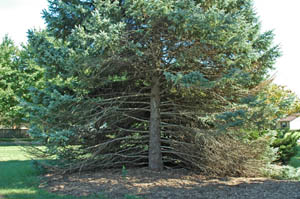Leucostoma (Cytospora) Canker of Spruce | |
|---|---|
| July 10, 2008 | |
|
Have you seen spruce trees like the one in the image? Leucostoma canker is also known as Cytospora canker, a name that seems to have stuck in the plant industry. The fungal pathogen is Leucostoma kunzei. Colorado blue and Norway spruces, especially those 10 to 20 years old have been reported to be the most susceptible to this disease. Like most canker diseases of trees, Cytospora is a pathogen that infects trees stressed by other factors. Some contributing factors include a limited root zone, moisture extremes, compaction of roots, chemical injury, nearby construction, and insect or mite problems. Possibly the shallow, spreading root system of spruce trees explains why they grow best in a moderately moist, well-drained soil and not as well in hot, dry, polluted conditions. The symptoms of Cytospora canker may gradually develop over several years. Lower branches usually die first, over additional dead branches scattered throughout the tree with time. The dead needles on the affected branches may remain attached or may drop prematurely. Another key symptom is the presence of cankers covered with white sap or resin, usually at the base of the affected branch where it attaches to the trunk. Large globs of sap usually indicate an insect problem. Sappy Cytospora cankers may also appear at axils of small branchlets. The sappy exudate is just a thin layer of dry, white sap. If the bark is peeled away from these affected areas on the branch, the wood underneath is brown. Black, pinhead-sized fruiting structures of the fungus may form in the inner bark, often within resin. There are no magic cures for Cytospora canker. Alleviate as much stress to the spruce as possible. Obviously this depends on site conditions, weather, and stage of tree decline. During dry conditions, prune and remove the affected, dead branches. Water the tree in times of drought (2 weeks without rain), and apply organic mulch over the roots and under the full spread of branches, but not against trunk. The mulch helps to retain moisture, maintain a consistent soil moisture and temperature for tree roots, and add to the organic matter in the root zone. For more information on Cytospora or Leucostoma canker of spruce, refer to Report on Plant Disease, no. 604, available at http://www.ag.uiuc.edu/~vista/abstracts/a604.html, or through your Illinois Extension office. | |
| Author: | Nancy Pataky |


